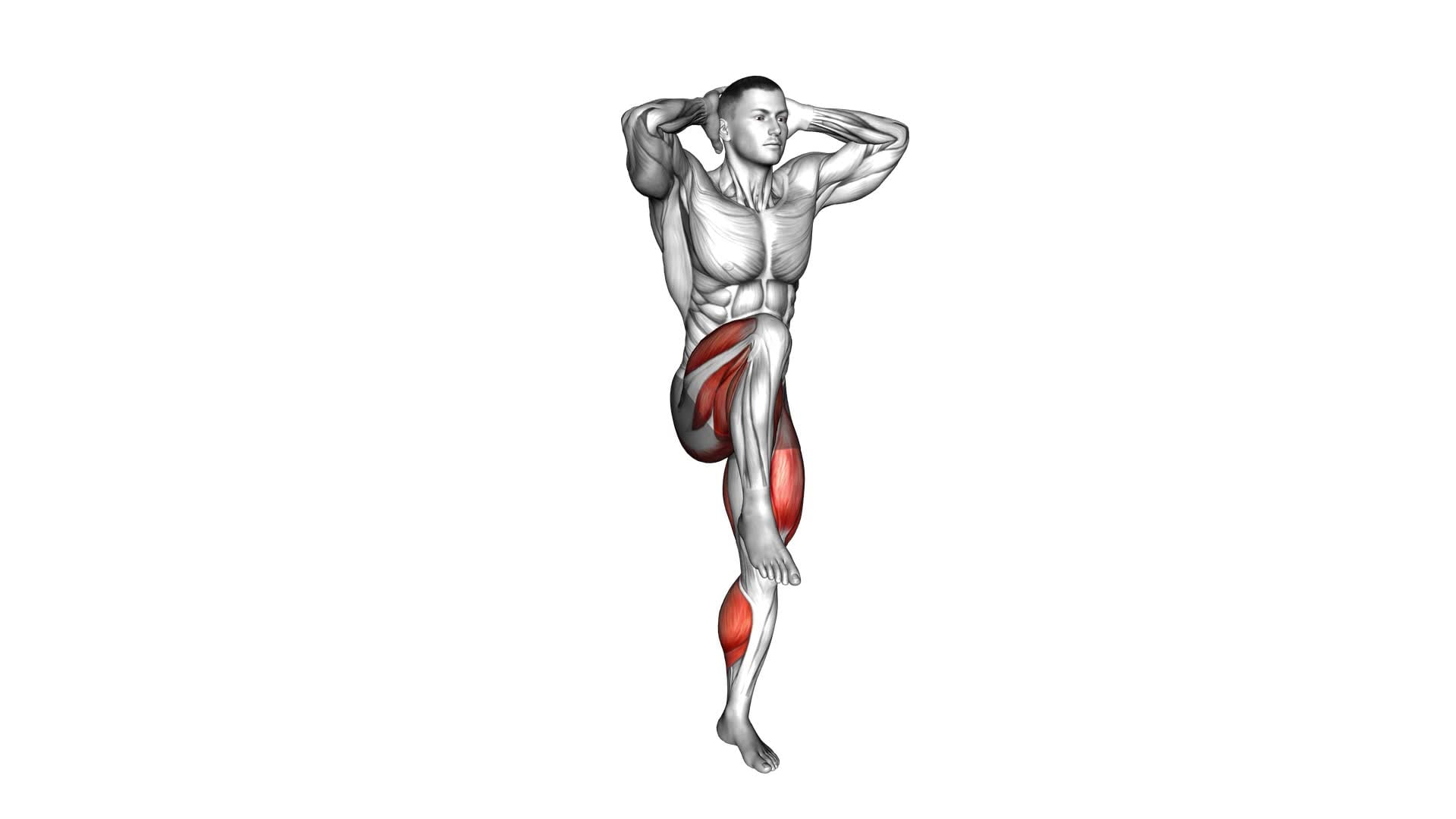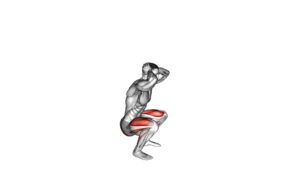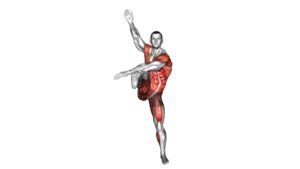Prisoner High Knee (male) – Video Exercise Guide & Tips

Get ready to amp up your workout with the Prisoner High Knee exercise!
Watch This Exercise Video
In this video exercise guide, we'll show you the proper form and technique to maximize your gains.
With variations to increase intensity and tips on avoiding common mistakes, you'll be on your way to getting the most out of this challenging exercise.
So grab your workout gear and let's get started!
Key Takeaways
- The Prisoner High Knee exercise elevates heart rate and improves cardiovascular fitness.
- It engages core muscles, including abdominals and obliques.
- The exercise targets quadriceps, hamstrings, and glutes for lower body muscle engagement.
- Proper form and technique, such as maintaining a straight posture and landing softly on the ball of the foot, are important in performing the exercise correctly and preventing injuries.
Benefits of the Prisoner High Knee
To maximize your workout, focus on the benefits of the Prisoner High Knee by engaging your core and increasing your heart rate. This exercise provides numerous health benefits and engages multiple muscle groups in your body.
The primary benefit of the Prisoner High Knee is its ability to elevate your heart rate, which helps improve cardiovascular fitness. By performing this exercise, you can effectively increase your heart rate and strengthen your heart muscle.
Additionally, the Prisoner High Knee engages your core muscles, including your abdominals and obliques. As you lift your knees toward your chest, you activate these muscles, which helps improve your overall core strength and stability. This exercise also targets your quadriceps, hamstrings, and glutes, making it an excellent choice for lower body muscle engagement.
Furthermore, the Prisoner High Knee is a dynamic exercise that promotes coordination and balance. By bringing your knees up while maintaining an upright posture, you challenge your body to coordinate movements and improve your overall balance.
Proper Form and Technique
How can you ensure proper form and technique for the Prisoner High Knee exercise? Follow these tips and tricks to avoid common mistakes and get the most out of your workout:
- Maintain a straight posture: Stand tall with your feet hip-width apart and engage your core. Keep your shoulders back and down, and avoid leaning forward or hunching your back. This will help you maintain balance and stability throughout the exercise.
- Lift your knees high: When bringing your knees up, aim to lift them as high as possible towards your chest. This will engage your lower abs and increase the intensity of the exercise. Focus on driving your knees up using your hip flexors, rather than swinging your legs.
- Land softly: As you bring one knee down, make sure to land softly on the ball of your foot. This will help reduce the impact on your joints and prevent any injuries. Avoid slamming your feet down or landing with a flat foot.
By following these guidelines, you can ensure proper form and technique for the Prisoner High Knee exercise. Remember to start slowly and gradually increase the speed and intensity as you become more comfortable with the movement.
Happy exercising!
Variations to Amp Up the Intensity
Looking to increase the intensity of your Prisoner High Knee exercise? There are several advanced modifications you can incorporate to challenge yourself and further increase the difficulty.
One option is to add ankle weights or resistance bands to your workout. These extra weights or bands will provide added resistance, forcing your muscles to work harder.
Another way to amp up the intensity is to perform the exercise on an unstable surface, such as a balance board or a Bosu ball. This will engage your core muscles even more and require greater stability, making the exercise more challenging overall.
Additionally, you can try incorporating a jump into the movement. Instead of simply bringing your knees up, explosively jump off the ground, bringing your knees as high as possible. This plyometric variation won't only increase the difficulty but also improve your power and explosiveness.
Remember to always maintain proper form and technique while performing these advanced modifications to prevent injury.
Common Mistakes to Avoid
Avoid these common mistakes when performing the Prisoner High Knee exercise. Proper breathing and injury prevention are key to maximizing the benefits of this exercise while minimizing the risk of injury. Here are three common mistakes to avoid:
- Holding your breath: Proper breathing is essential during any exercise. When performing the Prisoner High Knee, remember to exhale as you bring your knees up towards your chest and inhale as you lower them back down. Holding your breath can increase tension in your muscles and decrease your overall performance.
- Poor form: Maintaining proper form is crucial to prevent injuries. Make sure to keep your core engaged, shoulders relaxed, and back straight throughout the exercise. Avoid leaning forward or backward, as this can put unnecessary strain on your lower back and knees.
- Overextending your knees: While it's important to bring your knees up towards your chest, avoid overextending them at the top of the movement. This can put excessive pressure on your knee joints and increase the risk of injury. Focus on bringing your knees as high as comfortable without straining.
Tips for Getting the Most Out of Your Workout
To maximize your workout and achieve optimal results, focus on incorporating these tips into your routine. By following these efficient workout techniques, you can make the most out of your exercise sessions.
Firstly, make sure to warm up properly before starting your workout. This will increase blood flow to your muscles, improve flexibility, and reduce the risk of injury. Incorporate dynamic stretches and light cardio exercises to prepare your body for the upcoming workout.
Next, vary your workouts to keep your body challenged and prevent plateauing. Mix cardio, strength training, and flexibility exercises to target different muscle groups and maximize results. This will also help prevent boredom and keep you motivated to continue your fitness journey.
Additionally, pay attention to your form and technique during exercises. Performing exercises with proper form ensures that you're targeting the right muscles and minimizing the risk of injury. If you're unsure about the correct form, consider working with a certified personal trainer who can guide you.
Lastly, listen to your body and rest when needed. Overtraining can hinder progress and increase the risk of injury. Allow your body enough time to recover and adapt to the workouts. This will help you achieve better results in the long run.
Incorporating these tips into your workout routine will help you maximize results and make your workouts more efficient. Remember to stay consistent, stay motivated, and always prioritize your health and well-being.
Frequently Asked Questions
How Many Calories Can You Burn by Doing the Prisoner High Knee Exercise?
You can burn a significant amount of calories by doing the prisoner high knee exercise. This exercise offers numerous benefits, including improved cardiovascular fitness, increased leg strength, and enhanced coordination.
By engaging multiple muscle groups and incorporating high-intensity movements, the prisoner high knee exercise can help you burn calories and lose weight effectively.
Plus, there are various variations of this exercise that you can try to keep your workouts challenging and enjoyable.
Can the Prisoner High Knee Exercise Help in Improving Cardiovascular Fitness?
Yes, the prisoner high knee exercise can definitely help in improving cardiovascular fitness. By incorporating this exercise into your workout routine, you can elevate your heart rate and increase your oxygen intake, which in turn strengthens your heart and lungs.
The intense movements of the prisoner high knee exercise provide an effective cardiovascular workout, helping you improve your endurance and overall fitness level.
It's a great addition to your fitness regimen for reaping the benefits of improved cardiovascular health.
Is It Necessary to Warm up Before Performing the Prisoner High Knee Exercise?
Before performing the prisoner high knee exercise, it's recommended to warm up properly. Dynamic warm-ups help increase blood flow, flexibility, and prepare your muscles for the workout. This can help prevent injuries and improve your overall performance.
Additionally, focusing on maintaining proper form during the exercise is crucial to maximize its benefits. By engaging your core, keeping your back straight, and lifting your knees as high as possible, you can target your abs, hip flexors, and quadriceps effectively.
Can the Prisoner High Knee Exercise Help in Strengthening the Core Muscles?
The prisoner high knee exercise is a great way to strengthen your core muscles. By engaging your abs and hip flexors, this exercise helps to improve stability and increase overall core strength.
Additionally, the prisoner high knee benefits extend beyond the core, as it also works your lower body muscles, including your quads, hamstrings, and glutes.
There are various variations of the prisoner high knee exercise that you can incorporate into your workout routine for added challenge and variety.
Are There Any Modifications for People With Knee or Back Issues to Perform the Prisoner High Knee Exercise Safely?
When dealing with knee or back issues, it's important to find safe variations of the prisoner high knee exercise.
By modifying the movement, you can still strengthen your core without putting unnecessary strain on your joints.
Look for exercises that require less impact or weight-bearing, such as seated knee lifts or standing knee extensions with a resistance band.
Always listen to your body and consult with a healthcare professional before attempting any new exercises.
Conclusion
In conclusion, the prisoner high knee exercise is a great way to improve cardiovascular fitness and strengthen the lower body.
By following the proper form and technique, you can maximize the benefits of this exercise.
Additionally, by incorporating variations and avoiding common mistakes, you can amp up the intensity and challenge yourself even more.
Remember to stay focused and listen to your body to get the most out of your workout.

Author
Years ago, the spark of my life’s passion ignited in my mind the moment I stepped into the local gym for the first time. The inaugural bead of perspiration, the initial endeavor, the very first surge of endorphins, and a sense of pride that washed over me post-workout marked the beginning of my deep-seated interest in strength sports, fitness, and sports nutrition. This very curiosity blossomed rapidly into a profound fascination, propelling me to earn a Master’s degree in Physical Education from the Academy of Physical Education in Krakow, followed by a Sports Manager diploma from the Jagiellonian University. My journey of growth led me to gain more specialized qualifications, such as being a certified personal trainer with a focus on sports dietetics, a lifeguard, and an instructor for wellness and corrective gymnastics. Theoretical knowledge paired seamlessly with practical experience, reinforcing my belief that the transformation of individuals under my guidance was also a reflection of my personal growth. This belief holds true even today. Each day, I strive to push the boundaries and explore new realms. These realms gently elevate me to greater heights. The unique combination of passion for my field and the continuous quest for growth fuels my drive to break new ground.







